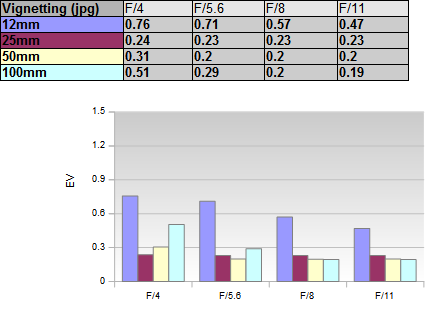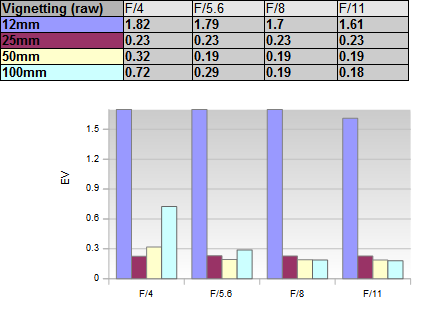|
Olympus M.Zuiko 12-100mm f/4 IS PRO - review / test report - Analysis |
|
Lens Reviews -
(Micro-)Four-Thirds
|
|
Page 2 of 3

Distortion
The Micro-Four-Third system uses an automatic distortion-correction thus from a user perspective, there is little to worry about here. Images only show a moderate barrel distortion (1.8%) at 12mm but there's barely something to report about beyond.
While most RAW converters as well as cameras (JPEGs) don't give you a choice, a few still do (e.g Capture One) thus it is possible to verify the original characteristic of the lens. With disabled auto-correction, the Olympus lens shows a massive barrel distortion of 6.9% (!) at 12mm. The situation isn't quite as bad at other settings though. At the long end, you can spot a medium degree of pincushion distortions. Barrel and pincushion distortions are equalized around the 25mm mark. Lesson learned -
disabling the image auto-correction is not a good idea.
Vignetting
Auto-correction is also applied to the vignetting characteristic. In this case, the system shows a relatively low degree (0.7EV) of light falloff at 12mm at f/4 and f/5.6 and slightly less so beyond. The issue is pretty much negligible at longer focal lengths.
 When looking behind the scenes again, things aren't that rosy anymore - at least at 12mm. The vignetting is very high at all apertures here peaking at 1.8EV (f-stops) at f/4. However, the light falloff is very much reduced at 25mm and 50mm. At 100mm you can traces of light falloff at f/4 again but this is acceptable.
When looking behind the scenes again, things aren't that rosy anymore - at least at 12mm. The vignetting is very high at all apertures here peaking at 1.8EV (f-stops) at f/4. However, the light falloff is very much reduced at 25mm and 50mm. At 100mm you can traces of light falloff at f/4 again but this is acceptable.

MTF (resolution)
Let me begin this chapter with two statements. It is impossible to design a reasonably-priced long range zoom that can truly play in the same league as high performance zoom lenses with a lesser range or even primes. On top of that comes the fact the we are talking about a lens with a maximum aperture of f/4. Due to diffraction Micro-Four-Thirds has its sweet spot around the f/2.8 mark - at f/4 the quality is already limited by diffraction. If you have a look at the following chart you will observe that the center quality is actually highest at f/4 which is not surprising (due to diffraction).
Keeping the above context in mind, the Olympus M.Zuiko 12-100mm f/4 Pro is actually darn impressive although it doesn't touch the best performing MFT lenses, of course. The center performance is great at 12mm f/4 and f/5.6. The outer image region is very good even at fully open aperture. The quality is still very decent at f/8 but you should avoid f/11 and beyond (-> diffraction). Remember that f/11 is equivalent to f/22 on full format cameras - you will rarely if ever need such a small aperture anyway. The sweet spot of the M.Zuiko is around 25mm. The center quality is marginally reduced here but the borders/corners are slightly sharper. The characteristic remains roughly intact at 50mm. At 100mm, the center quality is "just" very good. The border/corner is reduced but remains decent at f/4. In order to achieve the best performance you should stop down to f/5.6 here.
The tested sample had a good centering quality. The field curvature is minimal.
Side note: Out of curiosity I repeated the MTF tests at some settings WITHOUT distortion correction. The LW/PH figures were 10% higher at 12mm and 5% higher at 100mm - just to give you can idea that distortion correction is indeed lossy when it comes to the impact on resolution.
Please note that the MTF results are not directly comparable across the different systems!
Below is a simplified summary of the formal findings. The chart shows line widths per picture height (LW/PH) which can be taken as a measure for sharpness.
If you want to know more about the MTF50 figures you may check out the corresponding Imatest Explanations

Chromatic Aberrations (CAs)
Lateral CAs (color shadows at harsh contrast transitions) are very low and negligible by real world standards.

Bokeh
You don't really buy a 12-100mm f/4 MFT lens for shallow depth-of-field applications - remember that we are talking about a "24-200mm f/8" lens in full format terms. However, let's have a look nonetheless.
Out-of-focus highlights are reasonably well rendered. The inner zone of the discs is slightly nervous and there is a bit of an outlining effect which is getting emphasized the more you stop down.
 The rendition of blur in the critical focus transition zone is much better. Background blur (left crop below) is quite smooth and foreground blur is surprisingly silky.
The rendition of blur in the critical focus transition zone is much better. Background blur (left crop below) is quite smooth and foreground blur is surprisingly silky.

|